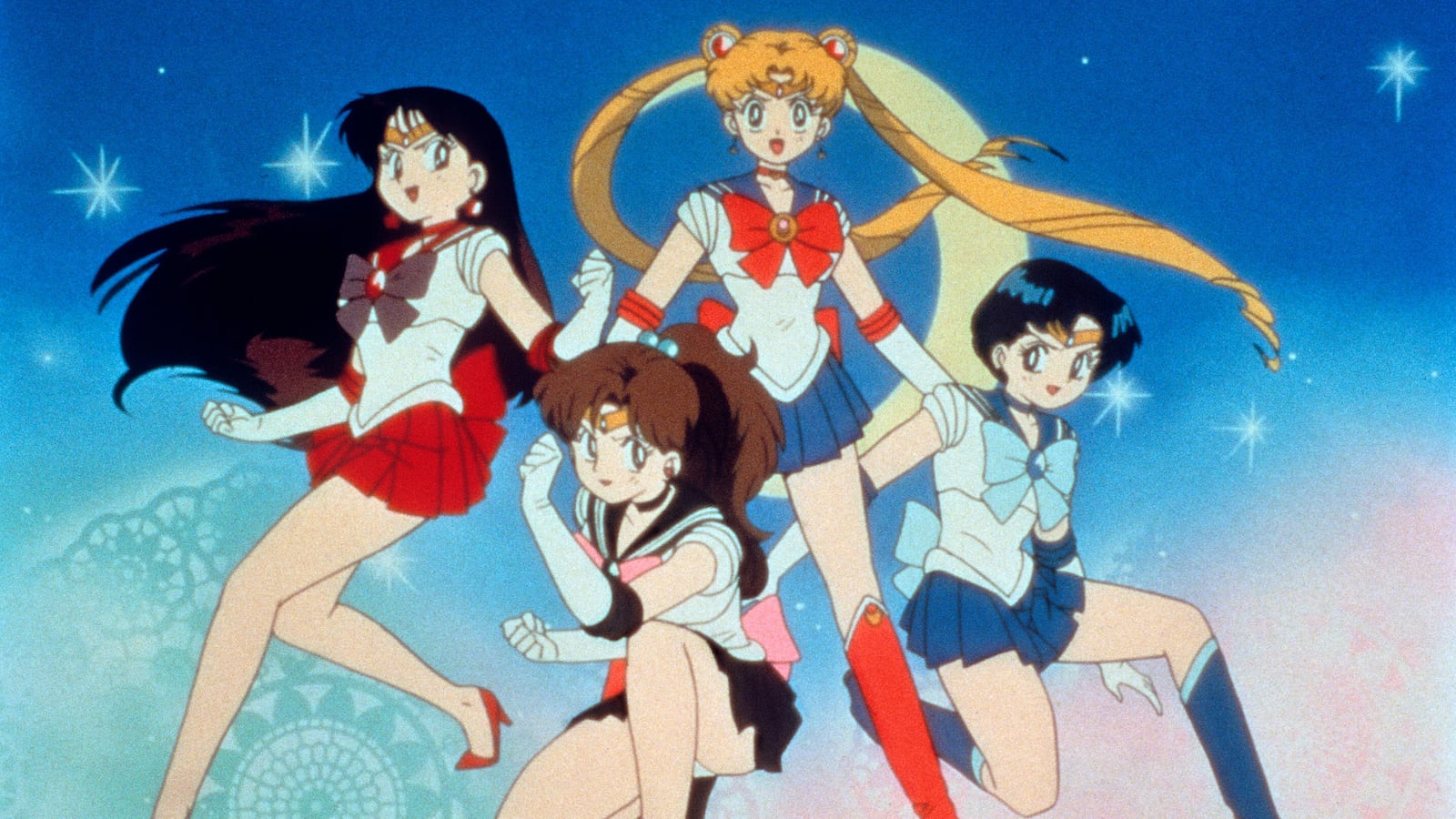Tsukino Usagi is back.
Starting this past summer, streaming video service Hulu broadcast the long-delayed, but all new, episodes of Sailor Moon Crystal (美少女戦士セーラームーン).
Adapted from the 20-year-old manga, Sailor Moon Crystal tells the story of middle school-aged Tsukino Usagi as she awakens from “ordinary” life as a clumsy, food obsessed, flibbertigibbet and becomes Sailor Moon, pretty guardian of the Moon Kingdom and queen of the galaxy.
Created by Naoko Takeuchi, the original series was a hit when released in Japan and continued the successful anime tradition established in properties like Project A KO and Kyōryū Sentai Zyuranger (known in North America as Mighty Morphin Power Rangers). The original Japanese anime ran for five years, from 1992 to 1997. An American adaptation of Sailor Moon followed, with names changed, scenes altered to meet American broadcast sensibilities (like reversing the side of the road on which cars drive and changing a villain’s gender to hide his gay relationship). The rights went to the legendary animation company DiC Entertainment, which produced other cartoon hits like Inspector Gadget and Captain Planet. The episodes aired weekdays in the early, early morning hours starting in September, 1995. Ratings were low. The impact huge.
When the initial run ended, USA and Cartoon Network purchased the episodes and showed them in syndication starting in 1997, commissioning additional dubs of the Japanese Sailor Moon series previously unaired in North America. Like the original series, elements of the show that made its American distributers uncomfortable were changed including making two female characters engaged in a romantic relationship into cousins.
One element that adaptations of the show have been unable to affect, and this is true of all Sailor Moon incarnations, English, French, German, Spanish, is that the stories are hauntingly beautiful, encompassing a wide range of human emotion and requiring great sacrifice on the part of the heroes.
Called “a badass alternative to Barbie” by MoviePilot.com, Sailor Moon Crystal plays up the domains competing for Tsukino Usagi’s attention. As it says in the original show’s theme song (and unlike male superheroes who spend their down time as mild-mannered reporters or playboy billionaires), Sailor Moon fights evil by moonlight then goes back to school every day, which, in Japan, translates to six days a week (plus evening instruction at a juku, a school that preps students for entrance exams). In short, unlike ordinary Japanese girls, who are already getting less sleep and working harder than most American adults, the Sailor Senshi also spend their nights as interplanetary guardians of love and justice.
In a medium that often minimizes its female characters with tokenism, or as minority-feisties, Sailor Moon has always had at her side the Sailor Senshi (セーラー戦士). Named for the four “inner” planets (Mercury, Venus, Mars, and Jupiter), and each armed with an elemental magic at their command, they are soldiers sworn to defend an ancient kingdom that existed on the moon. Not ones to shy away from a fight, the Sailor Senshi defend their leader to the death. Many Sailor Moon story arcs, in the comics and on television, end with the Sailor Senshi dying and being reborn.
All of the Senshi have character specific flaws that don’t disappear when they transform into their magical counterparts, and in some cases are caused by the strengths that make them exceptional. Sailor Mercury has a genius level IQ, but her intelligence comes at a high cost because she spends more time studying than she does socializing. Hino Rei (火野 レイ), Sailor Mars, is quick to anger, and critical of Usagi where the others are deferential, but her tough exterior causes the other Sailor Senshi to overlook her loyalty and commitment to the team. Examining the series’ feminism for Bitch Flicks, Myrna Waldron wrote, “Usagi’s character establishes that a good leader does not have to be someone unrealistically perfect. A good leader just needs to care for everyone equally.”
Sailor Moon Crystal is exceptional for flipping the script on gendered storytelling, and Chiba Mamoru (地場 衛) a.k.a. Tuxedo Kamen, is both Sailor Moon’s love interest and the series’ go-to “knight in distress.” Occupying the narrative space usually reserved for the lone female character in a cast full of men, Mamoru is often kept alive only by Sailor Moon’s protection. In their real-life interactions, the characters start out with no idea their alternate identities are in love with each other and they find ways to annoy each other. Mamoru taunts Usagi by giving her the nickname “dumpling head.” She tells him that he’s rude and mean. Creator Takeuchi has described the handsome, older (than Sailor Moon) boy as her favorite character in the series.
The Sailor Senshi rely on a central command which is run by two cats, Artemis and Luna. They are the former courtiers to the Moon Kingdom who were changed into domesticated short hairs when the Dark Kingdom launched an attack. Until Tsukino Usagi meets one of the transubstantiated felines, she is a normal teen girl, worried about tests and boys. Luna teaches her how to transform into Sailor Moon and often acts in loco parentis, dispensing sage advice that frequently contradicts Usagi’s impulsivity.
Sailor Moon Crystal is a more ambitious retelling of multiple Sailor Moon story arcs. The original anime introduced Sailor Moon and Tuxedo Kamen, brought the team together, and revealed the real villain across 31 episodes. The new series reaches the same point in only nine.
However, racing to fit as much of the original anime’s 89 episodes into 26 bi-weekly installments has elicited some complaints. DenOfGeek wrote that the initial series’ spending 33 episodes before the scene in which Sailor Moon and Tuxedo Kamen discover each other’s secret identities makes the reveal “that the person they most respect and are most irritated by are the same person is a real blow.” But the sped up story Sailor Moon Crystal meant “a few chapters/eps of some light interaction and square-one suspicion, followed up by a lightweight confirmation of what they pretty much already knew.”
Still, Sailor Moon fans are always ravenous for new content, especially after such a long time away. The original series launched a string of tie-in products including several live-action musicals, action figures, and even a Sailor Moon Light Up Dresing Table with Hairstyling Accessories. Cartoon Network’s Adventure Time worked in a reference by putting the gender swapped Fiona into Usagi’s “Princess Serenity” dress. An upcoming marketing tie-in for Sailor Moon Crystal will feature the main characters on packages of Koikeya Avocado and Cream Cheese flavored tortilla chips, which are “essential to women’s meetings.”
Sailor Moon Crystal is expected to wrap up its initial storylines by the end of the year. The most recent episode ended with Sailor Moon and her Sailor Senshi vowing to defeat the Dark Kingdom and the evil Queen Beryl-sama, who has kidnapped Tuxedo Kamen. By January, a whole new story line should begin, with even more Sailor Senshi and all new villains.
The need for a series like Sailor Moon almost goes without saying, but considering the twenty years since the series began (and the widespread intransigence toward the changes it foretold), it must be said that in a world where comic book fantasy stubbornly lingers overlong in male-oriented storytelling, Sailor Moon is an oasis for superheroes who can save the universe “backwards and in heels.”




